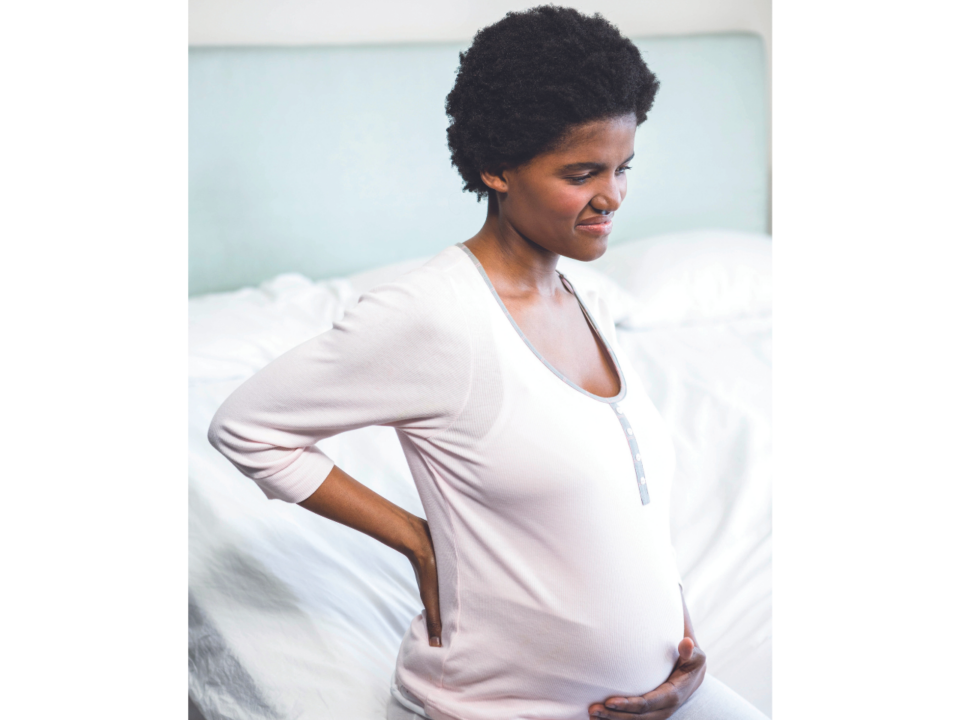The changing pregnant body may be one of Mother Nature’s more astonishing feats, but nothing grounds us like the aches and pains that tag along for the journey. Luckily, you can address most pregnancy pain gently, safely and effectively.
Why you shouldn’t ignore pain. If you’re like many women juggling multiple responsibilities, you might feel tempted to grin and bear it, but don’t.
“If you ignore pain and become increasingly less active, you can actually increase your pregnancy risks. Inactivity increases the risk of blood clots, for example, can weaken muscles, and may contribute to more complications or difficulty with labor,” says Dr. Michael Proffitt, OB/GYN.
Why the pain? As your body quickly adjusts to accommodate a growing baby, hormones cause your joints to loosen and relax, abdominal muscles stretch, and the pelvic bone separates. Furthermore, your center of gravity shifts as you gain weight. These factors combine to put extra strain on your musculoskeletal system.
Swap your shoes. Proper footwear can make a difference for aching joints and back pain. If you’re still sporting those stylish stilettos, it’s time to give them a break and opt for low-heeled shoes with good arch support.
Lift correctly. Ask for help rather than lifting heavy objects yourself. If you must lift something or someone–like your crying toddler–squat down, bend at the knees and keep your back straight while lifting.
Seek back support. Sit in chairs with good lumbar support, or place a small pillow behind your back while sitting. Sleeping on your side with a pillow between your knees can also help keep your back aligned.
“If your bed is too soft, place a board between the mattress and the box spring. This can help provide more support and alignment of the spine when you’re lying on your side,” Dr. Proffitt says.
Sometimes care providers recommend a prenatal cradle or support belt which holds the uterus and belly up a bit to relieve strain on the lower back.
Find relief. Apply hot or cold compresses to your back or opt for a prenatal massage. Massage can also help relieve tension and stress-induced headaches, common especially during the first trimester.
Exercise moderately. The exercises you choose to engage in during pregnancy depend on your pre-pregnancy fitness level. Avoid any exercise that incorporates sudden twisting or repetitive twisting. Walking, water aerobics and prenatal yoga can help you control your weight and strengthen your core muscles, which can relieve the strain on your back.
Feed yourself right. Drink plenty of water and maintain a nutritious, well-balanced diet to control your weight and manage headaches.
“Excess maternal weight gain has much to do with musculoskeletal issues such as back pain, neck pain and sciatica,” says Dr. Bret Gordon, OB/GYN. “Maintain a reasonable diet with reduced carbohydrates and lower caloric intake to keep your weight down. Over time, this will minimize the onset of musculoskeletal pain issues.”
Watch your sodium intake. Nearly every pregnant woman suffers from swollen ankles and feet in the final weeks of pregnancy. Support stockings can help. Dr. Gordon also suggests reducing your sodium intake and remaining well-hydrated.
Put your feet up. Rest can also ease swelling feet and ankles, headaches and pressure on your back. If you must sit or stand for long periods of time, prop one leg on a low stool and then switch legs to relieve the pressure on the lower back.
“The importance of adequate time off their feet is a tough sell to moms-to-be who have jobs, responsibilities and other kids who require their attention,” Dr. Gordon says. “But listen to your body. If it’s telling you to rest, you should.”
Try other therapies. Dr. Proffitt says many of his patients benefit from physical therapy when at-home pain management techniques aren’t working. Acupuncture or aquatics therapy can also help. If you elect for chiropractic care, he recommends seeking a chiropractor trained in treating pregnant patients.
Dr. Kezia Shine, who specializes in women’s health, pregnancy and pediatrics, says back pain is one of the most common reasons pregnant women seek her care.
“Especially for pain in the SI [sacroiliac] joint, which feels like a knife stabbing in the lower back when going from sitting to standing, or taking the first few steps when walking,” Dr. Shine says.
Reach out for mental health support. Just as emotional suffering can manifest as physical ailments, physical pain can hurt your overall sense of wellbeing contributing to depression or anxiety. Talk to your caregiver and circle of support if you’re struggling.
“When having a baby, mental clarity and sanity is of utmost importance because the stress hormone can pass through the mom’s blood to the baby, leading to a potentially stressed baby,” Dr. Shine says.
While pain is a normal part of pregnancy, contact your provider with any concerns. Your physician should be able to help you pinpoint the source of the pain and how to best manage it.
When to contact your doc:
- Chest pain
- Stroke-like symptoms
- Pain associated with fever, chills, nausea, vomiting, vaginal bleeding or changes in bowel habits
- Rhythmic severe back pain that comes and goes every few minutes, which could indicate preterm labor
Where does it hurt?
- Sciatica: shooting pain along the sciatic nerve that runs down one or both legs from the lower back. Can also be associated with a tingling sensation.
- Round ligament: sharp pain or jabbing in lower belly or groin common in the second trimester
- Pelvic girdle pain: Mild to severe discomfort usually occurring over the pubic bone in the front, below your stomach, along your lower back, in the thighs, or in the perineum.

